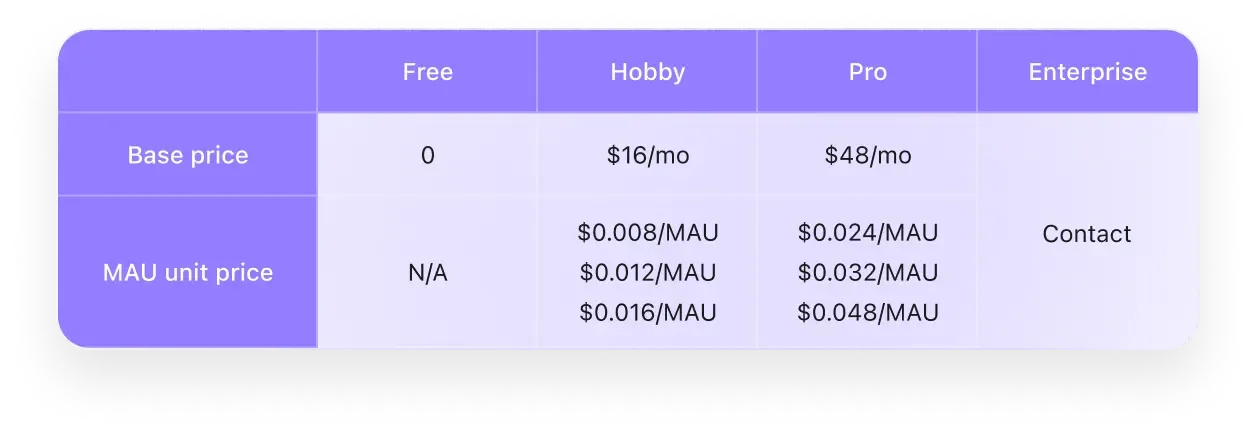Logto pricing model
Logto offers a pay-as-you-go and usage-based pricing model with a transparent measurement of Monthly Active Users (MAU).
Logto pricing strategy: Pay-as-you-go and usage-based pricing
As a foundational premise, Logto offers four plans: Free, Hobby, Pro, and Enterprise. The Free plan and the Enterprise plan operate differently with their own distinct approach while Hobby and Pro follow monthly usage-based pricing and are influenced by the number of Monthly Active Users (MAU).
The MAU is the primary variable that determines the monthly cost for Hobby and Pro plan subscribers.
MAU statistical caliber
Logto offers a transparent measurement of Monthly Active Users (MAU): An MAU refers to a user who has engaged in at least one token exchange with any Logto Cloud server within a billing cycle (30 days by default).
The formula
For most products in the market, the total monthly invoice is calculated as follows:
In the case of Logto, we introduce a tiered pricing model that allows for better segmentation of your Monthly Active Users (MAU) based on their levels of activity and engagement.
In the Logto environment, the formula for calculating the tiered MAU is as follows:
To gain a better understanding of how the formula functions, it's important to be familiar with the definitions of the variables involved.
- Total Monthly Invoice: The total amount of money customers are charged for Logto services within a 30-day billing cycle.
- Base Price: A fixed charge specific to each plan at the beginning of a billing cycle.
- Tiered MAU: The count of monthly active users who log in to the app within a specific range of days during a billing cycle.
- Tiered Unit Price: The price charged for each tiered MAU
Here's a table for reference:

Tiered MAU and tiered unit prices are key aspects of our pricing model. Let's delve into the specifics to better understand them.
Tiered MAU
A crucial question is how users are categorized into different tiers or segments based on their active login days in an app.
- Tier 1 MAU (Occasional MAU): If users engage in your app within 3 days during a month, they will be classified as Tier 1 MAU.
- Tier 2 MAU (Frequent MAU): If users engage in your app between 4 - 6 days during a month, they will be classified as Tier 2 MAU.
- Tier 3 MAU (Almost daily MAU): If users engage in your app beyond 7 days during a month, they will be classified as Tier 3 MAU.
Tiered unit prices
Naturally, the unit price is charged for each tiered MAU. In the case of Hobby and Pro plans, the following unit prices apply.
- For Tier 1 MAU (Occasional MAU), the Unit Prices are $0.008 for the Hobby plan and $0.024 for the Pro plan.
- For Tier 2 MAU (Frequent MAU): the Unit Prices are $0.012 for the Hobby plan and $0.032 for the Pro plan.
- For Tier 3 MAU (Almost daily MAU): the Unit Prices are $0.016 for the Hobby plan and $0.048 for the Pro plan.
Examples
I. The most simple example
Consider an app with 10,000 Monthly Active Users (MAU).
If all MAU are categorized under the Tier 1 pricing:
If all MAU are categorized under the Tier 3 pricing:
As a customer, you are allocated a monthly budget ranging between $96 and $176 in total.
II. A little bit complex example
Imagine an app with 10,000 Monthly Active Users (MAU) and an average of 6 sign-in days. In this scenario, the app experiences an average of 2000 Daily Active Users (DAU).
Let's consider the scenario where the app runs an ad campaign to acquire new users and experiences a spike in Daily Active Users (DAU) to 40,000 on the last day of the billing cycle. As a result of the campaign, approximately 38,000 new users join the app.
The total Monthly Active Users (MAU) for this month would then increase to 38,000 (new users) + 10,000 (existing users) = 48,000.
Considering the Monthly Active Users (MAU) count of 48,000, the price would be calculated like this if we follow the industry standard pricing model:
However, this doesn’t make sense. Our customers would feel wronged. 😢
Ironically, this scenario is extremely common for early-stage startups with unstable user volumes. Therefore, in this case, Monthly Active Users (MAU) is not an accurate representation of the actual usage.
As previously mentioned, the usual Monthly Active Users (MAU) for the app is 10,000 with an average of 6 sign-in days. This segment of users falls into the Tier 2 category. The remaining 38,000 users, who joined during the spike, would most likely be classified as Tier 1 MAU since this increase represents an unusual event.
| Tier 1 ($0.008/MAU) | Tier 2 ($0.012/MAU) | Tier 3 ($0.016/MAU) |
|---|---|---|
| 38,000 | 10,000 | 0 |
As a result, the total monthly cost for the unusual spike in MAU can be calculated like this:
Closing
We hope this article has provided you with a thorough understanding of Logto's pricing model. Please don't hesitate to reach out if you have any questions or would like to share your thoughts.

